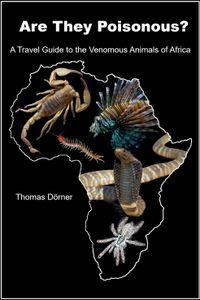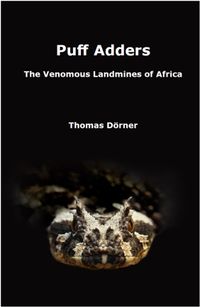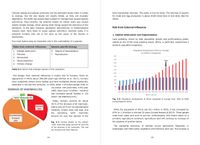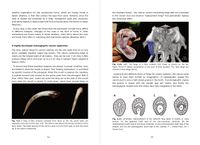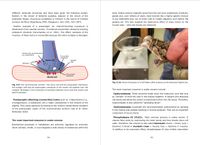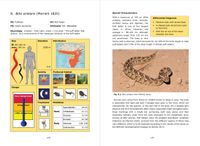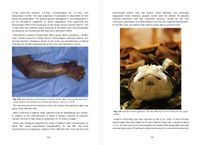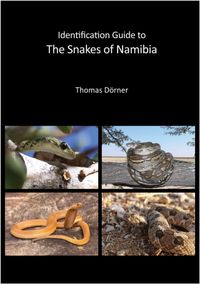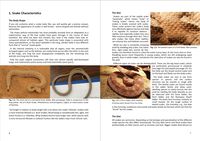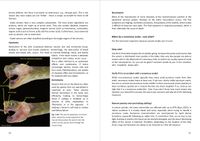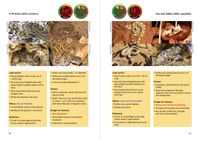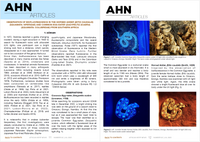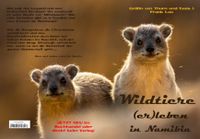Interested in more?
If you are interested in more information around vipers, their biology, systematics and venoms, you´ll find here futher literature, which is worth to read!
Brand New! "Are they Poisonous? " - A Travel Guide to the Venomous Animals of Africa = "Sind die giftig?" - Ein Reiseführer zu den giftigen Tieren Afrikas
“Is it poisonous?”
It´s the typical question of Africa travellers which expresses both fear and curiosity!
This book is your essential guide to Africa’s venomous wildlife. From snakes and scorpions to spiders and insects, discover the truth behind the creatures that inspire both fascination and dread.
Whether you’re trekking through the bush, conducting research, or simply captivated by nature’s more dangerous side, this book offers on more than 220 pages:
• Clear explanations of venom and its effects
• Life-saving first aid for bites and stings
• Detailed profiles of key species across Africa
• Over 135 illustrations for easy identification
This is more than a field guide—it's a call to respect and understand some of the continent’s most misunderstood creatures.
"Is it venomous?"
Find out—and be prepared.
The book is available in both German and English language
As printed book: Price: € 24,90 to be ordered directly per e-mail to: thomas.doerner@outlook.de
As e-book: Price: € 14,99 on the epubli-Store: https://www.epubli.com/shop/sind-die-giftig-9783818747909 (German) and https://www.epubli.com/shop/are-they-poisonous-9783819721571 (English)
The only monograph about one of the most amazing genera in the viper family!
Africa's largest venomous snake genus, the puff adders, has always had a huge fan base among venomous snake enthusiasts. And exactly for all these interested people this book is intended.
If you want to learn a little bit more about puff adders, a lot of research is needed. The abundance of partly very scientific publications makes it very time-consuming to get a holistic overview.
This book is therefore aimed to serve as a compendium to provide both a biological insight into the genus and information on the effect and treatment of snakebites, as well as the keeping and breeding of puff adders.
On 300 pages with more than 220 pictures the reader gets a deep insight into the biology of the puff adders and a detailed description of all species.
Didactically, the book is divided into two major parts:
The general part deals intensively in six chapters with the biology of vipers in general and puff adders in particular. Topics include systematic and evolution, habitats and distribution, risks and endangerment, anatomy of the puff adders, snake venoms and their mode of action. Another chapter is dedicated to the husbandry and breeding of this special group of animals.
The special part is dedicated to the description of all 18 Bitis species. The start of this part is made by an identification key, which helps to identify a present puff adder species exactly.
The description of the species provides an overview of the name, origin, size and danger followed by the characteristics of the species. A differential diagnosis describes how to recognize the snakes quickly. Continued topics are confusability, behavior, diet, husbandry conditions, breeding, and notes on toxicity. This structure makes it easy for the reader to quickly navigate the books and compare species.
The scientific claim of this book also does justice to the interested layman, and the reference list with more than 200 entries invites to deepen into the topic.
A glossary also explains the most important scientific terms.
Price: € 69,00 (+ shipping costs)
Take a look in the book:
Still new! An Identification Guide to the Snakes of Namibia!
The vast desert dunes of the Namib, the rugged rocks and mountains of the Karoo and the endless dry savannas characterise the wonderful, sparsely populated country Namibia in southern Africa. And despite the harsh, dry landscapes, the country is home to an abundance of wildlife. But beside the Big 5 (Elephants, Rhino, Buffalo, Lion and Leopard), the wild animal inhabitants naturally include snakes, which have conquered almost every one of these habitats.
When we humans are confronted with a snake, we immediately think:
“Danger! It must be venomous!”
But our perception is deceptive! There are approximately 85 different snake species in Namibia, but only nine of them have the potential to cause life-threatening symptoms in the event of an accidental envenomation.
This booklet takes you on an immersive journey into the captivating world of Namibian snakes, helping you to distinguish between venomous and non-venomous snakes of this fascinating country and thus to realise that the danger posed by snakes is much less than assumed.
Whether you're an amateur naturalist, or simply curious about the wonders of the natural world, 'The Snakes of Namibia' is your ultimate guide to the snakes of Namibia.
Short, precise descriptions help to quickly recognise the special characteristics of the different snake species and are shedding light on their remarkable diversity - from the smallest viper of the world (25cm) to a real giant of more than 6m in length. In addition, over 160 pictures visualise the descriptions and further support the interested layman to easily identify most of Namibia's snake species.
The book is rounded off with an identification key to Namibia's venomous snakes.
Price: € 17,90 (+ shipping costs)
Take a look in the book:
Interested?
Just send me an e-mail with your order to thomas.doerner@outlook.de
The books will also be availabe at the upcomming reptile fairs:
Terraristika Hamm, Germany, on the Saturday, 14.03.2025 in the venom room
Observation of Biofluorescence in the Horned Adder (Bitis caudalis) (Squamata: Viperidae) and...
The latest obseravtion of a special phenomenon! Biofluorescence has already been observed in many marine and terrestrial animals as well. However, there are only a view observations in snakes so far.
This publication reports about the first observation in the genus Bitis and Dasypeltis in southern Africa.
Citation: Dörner T (2023): Observation of Biofluorescence in the Horned Adder Bitis caudalis (Viperidae) and Common Egg-eater Dasypeltis scapra (Colubridae) from Southern Africa. African Herp News (AHN), Vol. 82, pp.
11-16
If you are interested in the full article, just click here on download.
Articles of Interest - Further Reading
Barlow a et al. (2019): Ancient habitat shifts and organismal diversification are decoupled in the African viper genus Bitis (Serpentes: Viperidae) - J Biogeogr. 2019; 00: 1–15.
Branch WR (1999): Dwarf adders of the Bitis cornuta-inornata complex (serpentes: viperidae) in southern Africa. - Kaupia. Darmstädter Beiträge zur Naturgeschichte 8: 39-63
Gutierrez LM et al, (2017): Snakebite Envenoming. Nature Reviews Disease Primers 3, 17063
New on the list: Jensen, T.J. et al. (2019): Exploring the international trade in African snakes not listed on CITES: highlighting the role of the internet and social media. Biodivers Conserv 28: 1–19 https://doi.org/10.1007/s10531-018-1632-9
Maritz B et al (2016): Identifying global priorities for the conservation of vipers – Biological Conservation 204: 94–102
Müller GJ, Modler H, Wium CA, Veal DJH, Marks CJ (2012): Snake bite in Southern Africa: diagnosis and treatment. CME October 2012; Vol. 30 No. 10 pp. 362-382
Wüster W et al. (2008): A nesting of vipers: Phylogeny and historical biogeography of the Viperidae (Squamata: Serpentes), Molecular Phylogenetics and Evolution; 49: 445–459
Youngman NJ et al. (2021): Widespread and Differential Neurotoxicity in Venoms from the Bitis Genus of Viperid Snakes. Neurotoxicity Research, https://doi.org/10.1007/s12640-021-00330-4
NEW: A friend of mine already published wonderful new books about the wildlife of my favorite country Namibia:
The book "Wildlife in Namibia" is intended as a guide for visitors to Namibia and nature lovers. With the help of this book, the journey through national parks, but also simply through the country, should become a unique experience. Important tips for preparing your trip complete this nature guide. In the book you will learn about: Elephant, buffalo, rhino, hippo, giraffe, eland, kudu, oryx, impala, springbok, steenbok, lion, leopard, cheetah, hyena, bat-eared fox, wild dog, baboon, bushbaby and many more...
The book is currently available in German language only.
For more information click on the picture and visit the homepage https://www.bush-live.com/bushlive-shop
A specialised books about Namibian Wildlife for Kids!
Mark is 9 years old and comes from Germany, Munich to be precise. He goes on vacation to Namibia with his parents and visits the Etosha National Park. Here he experiences many adventures!
Do you like animals as much as I do?
Big ones and slightly smaller ones, with fur or bristles, cross-striped or spotted or plain-colored? Some of them move very slowly, some are real sprinters, one of them even walks in a passing gait! Some are so small that they can fit in your arm, others are huge - there are even some that would look into your nursery window on the second floor if they were standing outside your front door. Some weigh as much as a car, many are as heavy as you! They all live in Namibia, many of them even on farms. But all of them are at home in Etosha National Park.
Join Mark on his adventures with the animals and learn their story...
The book is currently available in German language only. For more information click on the picture and visit the homepage https://www.bush-live.com/bushlive-shop
